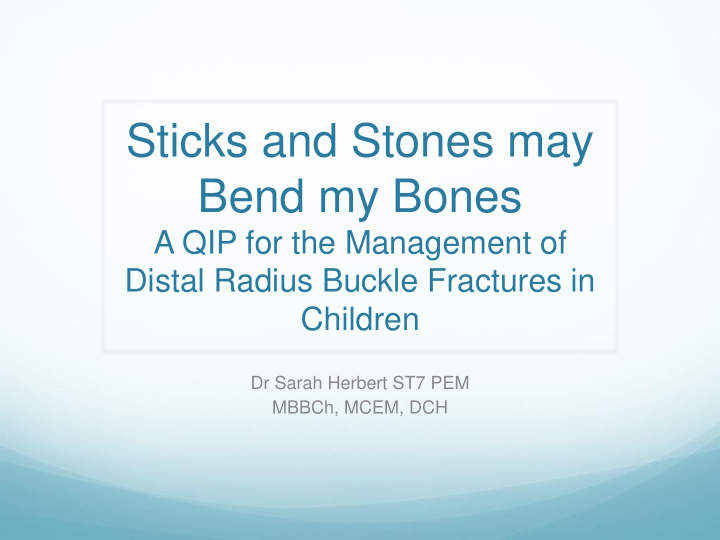



Sticks and Stones may Bend my Bones A QIP for the Management of Distal Radius Buckle Fractures in Children Dr Sarah Herbert ST7 PEM MBBCh, MCEM, DCH
Why? Most common fracture Common presentation to ED Plasters get wet - reattendance rates high Inconvenient for child and parent Uncomfortable for child
Identifying the Problem Scale 180 patients per year Nature Process Map Telephone Survey
Aims – What are we trying to accomplish? Improve Comfort Reduce Inconvenience
What change can we make that will result in improvement? I knew!!!!!! Bench Marking Literature Search Internet Search – pathways and proformas
Team Me PEM lead Consultant Paediatric Orthopaedic Consultants ENP lead CT3/PEM junior
What change can we make that will result in improvement? No fracture clinic follow up A removable device for immobilisation Safeguarding against greenstick fractures - VFC
How will we know the change is an improvement? Outcome Comfort Telephone survey Inconvenience answers (Satisfaction) Process Number of casts applied Data from PACS and Number of splints Zylab applied Balancing Number of greenstick Data from VFC fractures The data collected was plotted on SPC Charts
PDSA cycles Cycle 1 Pathway Patient/Parent information leaflet
PDSA cycles Cycle 2 Patients over 2 weeks seen by PEM junior New pathway used Followed up with telephone survey Worked really well
PDSA Cycles Cycle 3 Teaching Information sharing – emails/posters
SPC Chart - comfort scores (outcome) 7 6 5 Comfort Score (1-5) 4 Score Mean 3 UCL LCL 2 1 0 1 2 3 4 5 6 7 8 9 10 11 12 13 14 15 16 17 18 19 20 21 22 23 24 25 26 Patient Number
SPC Charts – Satisfaction scores (outcome) 14 12 10 Satisfaction Score (1-10) 8 Score Mean 6 UCL LCL 4 2 0 1 2 3 4 5 6 7 8 9 10 11 12 13 14 15 16 17 18 19 20 21 22 23 24 25 26 -2 Patient Number
Chart showing number of plasters and splints (process) 6 5 4 Number of Patients 3 Casts Splints Other 2 1 0 1 2 3 4 5 6 7 8 9 10 11 12 13 14 15 Week
Balancing VFC 0 greensticks Their projects outcome and process measures were showing it to be a success
Sustainability Working along side virtual fracture clinic QIP Induction teaching Online ED guideline Audit and Governance
Reflection and what I learnt Try to have an understanding of QIP methodology before you start Find the problem and then use a team to look for an aim and solution – DON ’ T approach the team with a preconceived solution Do small, manageable PDSA cycles Measure what you aimed to change and include process and balance measures Use your team Stick to a time frame, use a Gantt chart, keep a diary Do it in the hospital you are working in
Questions?
Thank you If you do not It is not enough to know how to ask do your best; you the right question, must know what to you discover do, and then do nothing your best If you can’t describe what you are doing as Without data a process, you you’re just don’t know what another person you’re doing with an opinion Quality is everyone’s responsibility
Recommend
More recommend